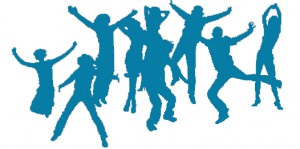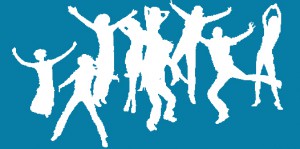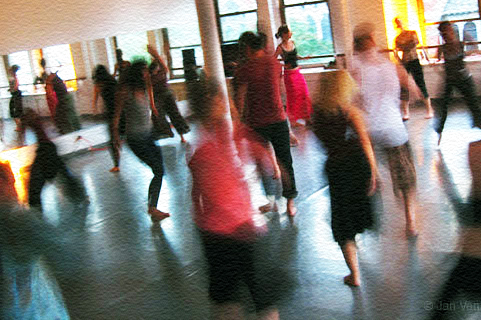“There’s mental inertia – my favourite – which is a whole bunch of philosophies and attitudes and beliefs – about yourself, about other people, about the world we live in, about groups of people. This – all – must – go! ” Gabrielle Roth, (1941-2012) Founder of the world-renowned movement practice “5 Rhythms” Dance
Loosening up
We’re in a high-ceilinged hall. There’s fourty five or so of us, male and female. We’re at the start of a 5 Rhythms dance class, loosening up minds and bodies, rousing physical and mental energies to overcome inertia, getting present, clear, and creative.
Warming up, we’re moving in all directions to flowing music as we begin to collectively inhabit the empty room. Walking barefoot on the warm, wooden, well-worn floor, we’re shuffling, strolling, striding, as befits our mood while traversing the space. Sensing those around us as we do so, we catch each other’s eyes, self-consciously or in recognition, notice each other’s form, movement and demeanour.
Our attention is placed equally on those around us and on ourselves, as we bring our mental attention in tune with the motion of our bodies and adapt the line of our track. Our focus is on avoiding and relating to the form and dynamic physical obstacles we each present Sometimes (but remarkably little) we stutter, trip, knock into each other and the flow is interrupted. Our 5 Rhythms teacher for the session calls out hints and suggestions for what angle to focus on as he too walks amongst us.
calls out hints and suggestions for what angle to focus on as he too walks amongst us.
“Make eye contact with people as you pass – notice how that feels“…”Walk at the speed and in a way that matches your energy“…”If your mind is full of judgements and beliefs about how you should move, let them go“.
So what has this to do with better thinking? A number of threads are relevant. As solid objects in each other’s paths, we metaphorically represent the rock-like chunks of unexamined thoughts, beliefs, and assumptions we each hold, and around which we each dance. We’re also making our thoughts visible through the shape, tone and texture of our movements – that which we embody is finding its own expression. As we let go of ideas and expectations, we are aiming for our minds, as well as our bodies, to move, flow, and open. Mentally, we’re practising and rehearsing a felt sense of adapting to the “in the moment” reality, staying flexible, agile and alert, experimenting and working with the circumstances as they are presented to us, loosening and letting go, being creative with new possibilities, finding new inner territory.
Because we have to think quickly – indeed subconsciously – when we move rapidly in a crowded space, our natural body-based thinking, its remarkable capacity, it’s limitations, and how our conscious thought interferes is made directly visible to us. Both in the metaphors of movement, and in the direct experience of conscious and subconscious mental processing we see our thinking directly.
Following the empty space
After a few minutes of walking around each other, the emphasis changes. The new direction comes from the teacher:
“Follow the empty space, where the space opens up, move there. If you find yourself stuck, turn on the spot, keep turning until the space opens out.”
This feels different! Suddenly, the mind frees up as the need to relate to, and move around “what is” is replaced by an adventurous, spontaneous awareness of where the “what could be” will next appear. There’s no tim e or room for preconceived notions of what will happen. It’s not possible to plan, but only to respond dynamically in the moment. The collaborative freedom increases as we all focus on just the space, moving, forwards or backwards, diagonally, twirling, twisting and tracking the emptiness. The chessboards of our minds free up as we dissolve its grid-like grip on our consciousness. All those held ideas, dogmas, things we hold to be true come what may; the assumptions, beliefs and frozen ideas and ideals to which we anchor start to melt further and our inner space gradually becomes one space.
e or room for preconceived notions of what will happen. It’s not possible to plan, but only to respond dynamically in the moment. The collaborative freedom increases as we all focus on just the space, moving, forwards or backwards, diagonally, twirling, twisting and tracking the emptiness. The chessboards of our minds free up as we dissolve its grid-like grip on our consciousness. All those held ideas, dogmas, things we hold to be true come what may; the assumptions, beliefs and frozen ideas and ideals to which we anchor start to melt further and our inner space gradually becomes one space.
The class continues with a “Wave” of un-choreographed movement mimicking a cycle of growth and transformation through the rhythms of Flowing, Staccato, Chaos, Lyrical and Stillness to matching music. I return home, wet with sweat, clear, happy, and energised. As often happens, over the next few days, the dance has moved me forwards: I have fresh insights, new patterns of thinking form, and I feel re-invigorated. Mental inertia and stuckness give way to liveliness and brightness. Once again, engaging in 5 Rhythms has helped me, not only physically, but also in creating the conditions for “Better Thinking”.
In the Moment
In looking for inspiration for this article, I was curious to know whether engaging in prescribed, structured movement, such as choreographed dancing, had similar benefits. In doing so, I came across Grier Cooper “The writer in a dancer’s body“. I asked her how her dancing helped with “better thinking” and in what way. She generously shared her thoughts with me from California:
“I began as a ballet dancer and performed with San Francisco Ballet and Miami City Ballet but since then I’ve practiced many other forms including Modern, African, Afro-Haitian, Samba and Salsa. I love all forms of dance, especially those I can do barefoot! Dance has become a form of moving meditation, a sanctuary that allows me to get out of my head and into my body; to breathe, move and move energy. When I dance I remember there is only this breath, only this moment and everything else falls away. I have a feeling that you will understand this since you also practice 5rhythms”.
Only this breath, only this moment – a striking thought. Gabrielle Roth echoes this too, in the continuation of her quotation above: “And we have to consider the 5rhythms as a vacuum. And it is meant to clean us out of all the past, of everything that is unncessary, to being a spirited breath in the moment“.
Outsmarting Dogma
This agile adaptation and flowing awareness of the moving moment that we get to in dancing must be the essence of how we “dance our way out of dogma” in our thinking – indeed in business, and software design ‘agile’ thinking processes are trendy buzz words. Concepts form and attract, we hold onto them; we have set patterns of belief, “mindsets” “attitudes” and “biases”. It’s what the mind is good at – creating and sticking to programmed patterns, repetitive familiar thoughts and moves, however simple or complex, and our egos follow suit. Eventually, any belief, strategy, philosophy or dogma – whether intellectually supported or emotionally attached to – becomes the places where we stick, the caged structures that encase us. We become mentally fixated and immobile as inertia sets in: change becomes unthinkable, so we need methods to actively outsmart this tendency to be dogmatic.
There are many useful tools and techniques which can help us. One the one hand, we can use tools to both see and sidestep those “rock-like” obstacles we don’t even realise we’re mentally working around which block our view of what’s possible in the present, and on the other, there are methods to help us find and move into fresh new spaces. I’ll mention an example of each here.
Removing the Obstacles to our Thinking
Just as in the dance, part of us is acting as choreographer determining where and how to move and what to avoid, so for our thinking, background ideas and beliefs are shaping the direction of our thoughts. These act as anchors or assumptions and create invisible obstacles to change. For any endeavour, and for any form of change that we want to bring about, therefore, we can consider: “to which tune are we dancing?” We can enquire of ourselves:
- “What assumptions are we making for this situation?
- What are we assuming must be true? What seems so obvious that we don’t consider changing it?
- What factors are we so attached to that we can’t even consider changing them in any way?
When we’ve outlined those assumptions, we can not only recognise the fixed points around which we navigate our thinking, but we can also exercise our creative minds to challenge them and find new spaces to inhabit.

Following the Empty Space
In our businesses and organisations, we could make use of the “Canvas strategy” technique and other methods outlined in “Blue Ocean Strategy” to find and create “uncontested market space and make the competition irrelevant“. Based on a study of 150 strategies taken in over more than 130 industries, the authors suggest that lasting success comes from creating ‘blue oceans’: open spaces of untapped new markets ready for growth. We can thus move away from the crowded “bloody red shark-infested oceans” where companies compete with similar levels of value and on similar dimensions, and continue to be aware of how that space is closing or opening up.
For the Strategy Canvas, (available as an app, or use good old pen and paper) we create an axis, with “high to low” on the left, and along the bottom, we identify the dimensions on which companies compete. For any market, we can then map the different companies in this market space, including our own and find new space by creating new dimensions and different values.
Only this Breath
There’s much that can be said on this fascinating topic of how we work with dogma and fixed views to bring about change and transformation, whether chosen or imposed. So when, for example, you’re in a meeting or conversation, with your thoughts flitting from this to that, try envisioning it as a dance, and ask if you’re dancing with, or bumping into your colleagues, and whether you’re moving to someone’s tune, or agile on your feet dancing into new unoccupied opportunities.
I’d be fascinated to hear what ideas and methods you find helpful in keeping a continuously open fresh view, for your individual and collective journeys in “only this breath, only this moment“.
For after all, it is always helpful to remember and maintain the perspective that “This – all – must – go!” – as indeed, Gabrielle Roth herself did, just over a year ago.
Sophie Brown
References
5Rhythms of Dance – Gabrielle Roth A 30 minute video. See just the first few minutes for a description and examples of this in practice. And do watch from 3.00 to 3.48 minutes to hear and see Gabrielle teaching the “There’s mental inertia… moment” piece. See also this article on Gabrielle.
Dance 5 Rhythms: see http://www.5rhythms.com/
Grier Cooper: The Writer in a Dancer’s Body
A professional dancer and instructor for more than thirty years, Grier performed worldwide with dance companies including San Francisco ballet, Miami City Ballet and Pacific Northwest Ballet. Her work has been published in the Daily Book of Photography, Skipping Stones, Unity Magazine and Education.com, among others. She currently writes a dance column for BAY STAGES magazine and both fiction and non-fiction for children and adults.
“Blue Ocean Strategy” by W. Chan Kim and Renee Mauborgne, 2005, Harvard Business School Publishing Corporation.
Photo credit
Dance class – via Souls Code

